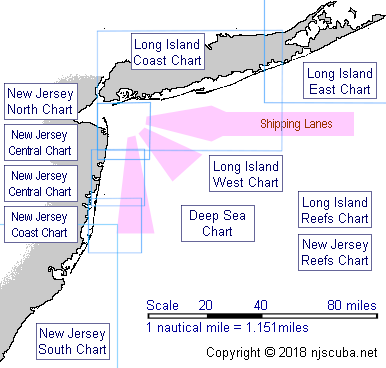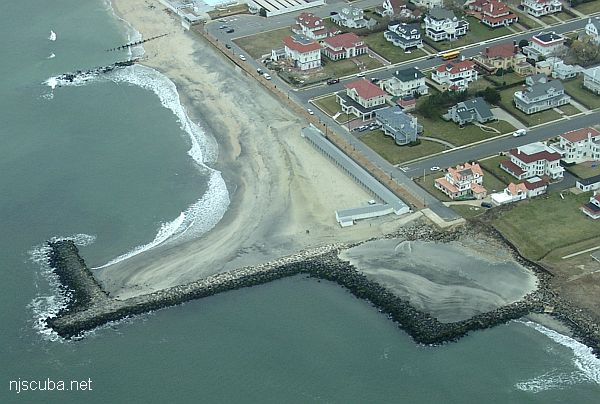Lost At Sea (3/9)
Intense Rescue Effort Begins
There was no Mayday call. There was only the tense voice of Capt. Edward McLaughlin coming through the VHF radio in the wheelhouse of the clam boat Danielle Maria, telling first mate Larry Kirk that McLaughlin's vessel was taking on water "big time." Kirk squeezed the microphone knob and asked McLaughlin for the position of his boat, the 84-foot steel quahog dredger Beth Dee Bob.
McLaughlin responded with coordinates from his Loran, an electronic plotting device. The figures placed Kirk and the Danielle Maria 15 miles to the southeast of McLaughlin. It was 5:40 p.m. on Jan. 6, 1999, off the New Jersey coast. The sun had set. The temperature was dropping. And snow flurries blew in steady 30-knot winds that took the foam off the tops of a heaving sea.
Kirk entered McLaughlin's coordinates into his autopilot on the Danielle Maria. Then his boat, which had been traveling west and taking hard shots against the port bow from 10-foot waves and occasional 15-footers, turned to the north. With the same big waves rolling the 110-foot dredger from side to side, Kirk steamed toward his stricken friend.
It had been five minutes since McLaughlin's call, so Kirk hailed him on the VHF. He tried Channel 66, one of the frequencies mariners use for non-emergency conversation, and got no answer. He turned to Channel 70, where clammers who worked for PMD Enterprises of Cape May sometimes carried on their idle chatter. Again, there was no reply. Concerned, Kirk switched to Channel 16, a frequency restricted to hailing other vessels and emergency communications. After 10 minutes with no luck, he radioed the U.S. Coast Guard station at Manasquan Inlet, in Point Pleasant, and provided the Beth Dee Bob's coordinates.
Things happen fast on the water. Storms that the National Weather Service hasn't predicted and can't track build up in minutes. And fishing boats - little floating factories laden with their catch - can, once they are in trouble, sink in minutes, sometimes in seconds.
Anyone who knew McLaughlin, 36, knew he would try first to save his boat and then to survive. He had a lot to live for. Until his son, Liam, was born two years before, McLaughlin was like many commercial fishermen: "They party hearty; work hard, come into the dock and drink hard, " said John Graziosetta, 49, a mechanic who maintained the Beth Dee Bob. With a boy at home, McLaughlin now "had focus."
If the worst had happened - if the Beth Dee Bob's crew had to abandon ship - the best possible outcome would be that the four men had time to get into their survival suits, that their life raft had automatically deployed from its canister atop the boat's wheelhouse, and that they were tossing in that violent sea, the orange penlight-sized strobe lights attached to their chests flashing their positions.
With such a sudden loss of radio contact, this outcome had to be on everyone's mind as, from out at sea and from the clam dock in Point Pleasant, every available fishing boat joined in the rescue effort. That effort began at 5:55 p.m., when Fireman Keevan Walker, standing watch in the Manasquan Inlet Coast Guard Station, received Kirk's radio message. Walker started a chronological record with the Beth Dee Bob's last known coordinates and then called the officer of the day, Petty Officer Colin Redy.
Redy ordered a 41-foot Coast Guard vessel - identified by its number, 41300 - to divert to the scene from a training run. Then the calls started coming in from other fishing boats that were changing course to converge on the Beth Dee Bob. The Jamaica, the Christian & Alexa, the Flicka all called, even as a Coast Guard helicopter, on a training run over the ocean from Atlantic City, was ordered back to base to get a pump to bail out the stricken clam boat.
It had been less than 10 minutes from the time McLaughlin first realized something was wrong until he called the Danielle Maria to say he was taking on water. McLaughlin and his first mate, Jay Bjornestad, 38, were in the wheelhouse. The Beth Dee Bob's automatic pilot steered them through pounding seas toward the clam dock in Point Pleasant, where they intended to unload the product of their last day's labor - 2,240 bushels of ocean quahogs worth $8,960.
Deck hand Roman Tkaczyk, 48, was asleep in a berth in the crew's quarters at the foot of the stairs leading down from the rear of the wheelhouse. Crew member Grady Gene Coltrain, 39, had left his berth below the boat's waterline. The 675-horsepower diesel was now throttled down to an idle as McLaughlin tried to understand the problem. The boat was still moving forward, but at nowhere near the nine or ten knots it normally made. Instead of beating against the oncoming waves, the Beth Dee Bob rose and fell almost docilely in 10- and 12-foot seas.
Taking on water, the boat may have seemed more stable. With two television cameras in the engine room at the rear of the boat, McLaughlin would have been able to see whether that space was flooding. What he could not see was whether the clam hold, carrying 56 steel cages filled with ocean quahogs, had taken on water, or whether the large void spaces around the welded steel box of the hold had opened up to the sea. Checking the voids would require climbing down into the boat. To determine whether there was water in the clam tanks, a skipper would watch the stern of the boat to see whether water was washing over the clam tank hatches and whether the boat was listing. If it was, he would start up the pumps in the hold. On the Beth Dee Bob, the valves controlling the pumps were at this moment all closed.
The first indication that there was a problem may have been the way the stern of the boat settled. The Beth Dee Bob normally rode very close to the water, and it was not uncommon for seas to break across its aft deck and then slide off through the scuppers along the rails. Whatever was happening now, it came suddenly. There was no time to rouse Tkaczyk from his bunk nor to run down to the galley, next to the bunk room below the wheelhouse, where the red survival suits were stored. As later evidence would suggest, the Beth Dee Bob was about to simply sink, without listing or capsizing.
The huge lamps that lit the deck machinery of the Beth Dee Bob were still burning white-hot when the water began rushing down the stairs, the only escape route from the galley and the bunk rooms. Tkaczyk, whose labors fed and housed a wife and 14-year-old son in Gdansk, Poland, was about to drown. Then the ocean poured into the wheelhouse. The men in the wheelhouse had no choice. Those who were not now caught in the recesses of the clam boat stepped out into the Atlantic. The water temperature was in the low 40s. The men wore only their work clothes and boots.
As he stepped out the door, Jay Bjornestad, wearing coveralls and knee-high rubber boots, grabbed from its hanger on the outside wall an orange life ring to which was attached a strobe light. Then he was in the numbing, icy waters. If they were in the wheelhouse with Bjornestad, McLaughlin and Coltrain may have joined him clinging to the life ring. But even as the Beth Dee Bob slipped under the waves, its bright lights finally extinguished, any man left in the heaving blackness of the frigid water had, at best, less than an hour to live.
In 45-degree water, hypothermia - the loss of body heat - progresses in rapid stages. First, there is profound shivering as the body tries to warm itself. If the body's temperature continues to fall, the shivering stops. There may also be a brief period of aching, but then the victim falls into a stupor, a rather pleasant and painless condition followed by coma. At a body temperature of about 90 degrees, a revived victim will suffer amnesia. If the victim is not revived, the body stiffens as the muscles contract. The heart, in time, ceases to function.
By 6 p.m., 20 minutes after McLaughlin's distressing call on the radio, a dozen or more boats were converging on 40 degrees, 8 minutes north, 73 degrees, 40 minutes west. And in the sky, an orange HH65 Dolphin Coast Guard helicopter was on its way. In the front of its minivan-sized cabin were the pilot, Lt. Scott McFarland, and his copilot, Lt. Edward Beale. Behind them in a jump seat rode Petty Officer Richard Gladish, 35, who had spent 14 years saving lives as a Coast Guard rescue swimmer. He wore a dry suit, a harness with all of his life-saving gear, fins, and a mask. When they got to the Beth Dee Bob or its crew, Gladish would be the one to hit the water and bring the men back alive. Until 6 p.m., this had been a training run for the helicopter crew. Now, flying at 140 knots to the northeast along the New Jersey coast, it was the real thing.


